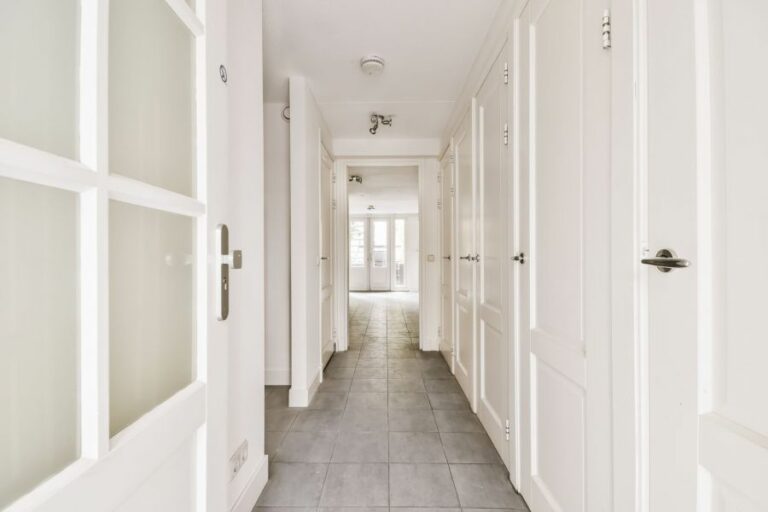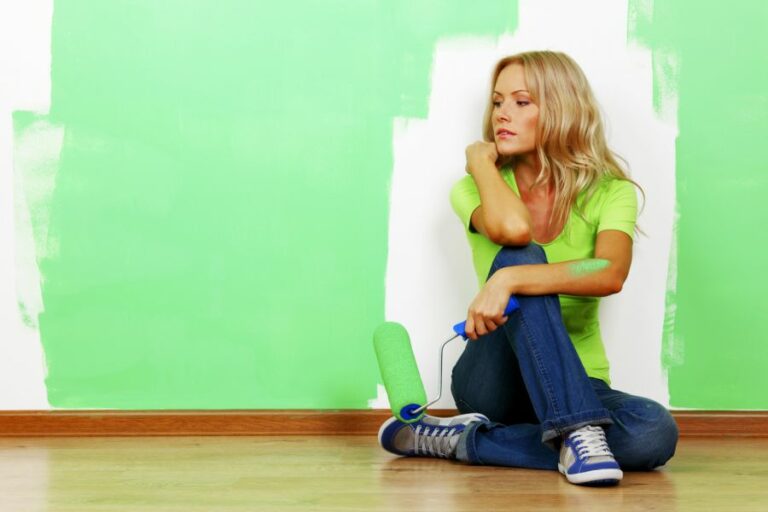Indoor Wall Paint: Acrylic Vs. Latex, 25 Things You Should Know
Are you Looking to repaint your home’s walls but unsure whether to go for acrylic or latex paint? Good news – you’ve come to the right place. Let’s delve into the main differences and advantages of these two popular paint types, helping you to make a confident, informed decision that’s perfect for your space.
Indoor wall paint: acrylic vs. latex:
Acrylic paint is more durable and resistant to moisture, mildew, and UV rays, making it suitable for high-humidity areas like bathrooms and kitchens. Latex paint, being more cost-effective and low-odor, is ideal for general living areas, bedrooms, and spaces where odor and cost are primary concerns. Both paint types are water-based and environmentally friendly.

Want to give your walls a fresh look but unsure whether to grab acrylic or latex paint? Fear not! Discover the key differences between these popular paint types, explore their advantages and drawbacks, and determine which one will best fit your home. Read on!
Contents
- 1 Acrylic vs. Latex: Choosing the Ideal Indoor Wall Paint
- 2 Drawbacks of Using Acrylic Paint on Walls: A Closer Look
- 3 Evaluating Acrylic Paint for Interior Wall Applications
- 4 Deciding Between Acrylic and Water-Based Paint for Walls
- 5 Comparing Latex and Acrylic Paints for Interior Wall Projects
Acrylic vs. Latex: Choosing the Ideal Indoor Wall Paint
• Introduction to Indoor Wall Paints
Indoor wall paints determine the overall appearance and durability of the walls of any living or working space. Choosing the right type of paint can greatly enhance visual aesthetics, and it should be more than just a decision of color preference.
The two primary types of paint used for indoor walls are acrylic and latex.
• Acrylic Paint: Features and Benefits
Acrylic paints are a popular choice for a variety of painting projects due to their versatility, durability, and ease of use. Made with synthetic resins and pigments, acrylic paint is generally water-based, making it a more eco-friendly option than oil-based paints.
Some of the key features and benefits of acrylic paints include:
– Quick Drying Time
Acrylic paints are fast-drying, which allows for quicker completion of painting projects. This can be particularly helpful when working on a tight schedule or when applying multiple coats.
– Durability and Resistance
Acrylic paints are known for their durability and resistance to various factors such as moisture, mildew, and UV rays. This makes them suitable for areas that experience high humidity or direct sunlight, ensuring the paint does not chip, peel or fade over time.
– Easy Cleanup
As acrylic paints are water-based, clean-up is relatively simple. Brushes, rollers, and other painting equipment can be easily cleaned with soap and water, eliminating the need for harsh chemicals and solvents.
– Adhesion
Acrylic paints have excellent adhesion properties, allowing them to bond well to a variety of surfaces, including previously painted surfaces. This helps to create a smooth, even finish and reduces the risk of peeling or flaking.
• Latex Paint: Features and Benefits
Latex paint, also known as water-based paint, is made up of a mixture of water, pigments, and binders such as acrylic or vinyl. Latex paints are widely used for indoor wall painting due to their easy application, cost-effectiveness, and low-odor properties. Here are some key features and benefits of latex paints:
– Low Odor
Latex paints have a minimal odor compared to oil-based paints, making them a more pleasant option for indoor use, especially in confined areas with limited ventilation.
– Environmentally Friendly
As latex paints are water-based, they have a lower volatile organic compound (VOC) content, making them more environmentally friendly. In addition, the low-odor properties of latex paints can help reduce air pollution and improve indoor air quality.
– Easy Application
Latex paints are known for their smooth and easy application, allowing for even coverage and a uniform finish. This can be particularly beneficial for inexperienced or DIY painters.
– Quick Drying Time
Similar to acrylic paints, latex paints dry relatively quickly, making it possible to complete painting projects in a shorter period.
• Acrylic vs. Latex: Comparison and Recommendations
While acrylic and latex paints share some similarities, there are distinct differences between the two that can influence the choice based on the specific requirements of a painting project.
– Durability
When it comes to durability, acrylic paints have the upper hand, as they offer better resistance to moisture, mildew, and UV radiation. For areas that experience high humidity, such as bathrooms or kitchens, acrylic paint is recommended.
– Environment and Health Considerations
Both acrylic and latex paints are water-based and contain low VOCs, making them more environmentally friendly than oil-based paints. However, latex paints generally have lower odor levels, making them a more suitable choice for sensitive or allergy-prone individuals.
– Cost
Latex paints are typically more cost-effective than acrylic paints, making them an attractive option for budget-conscious consumers or large-scale painting projects.
– Expert Recommendations
Based on personal experience, acrylic paint is recommended for areas that require higher durability and resistance, such as bathrooms, kitchens, or rooms with high humidity.
Latex paint, on the other hand, is a more economical and low-odor option, making it suitable for general living areas, bedrooms, and other spaces where odor and cost are primary concerns.
More information on the differences between acrylic and latex paints can be found in this Environmental Protection Agency (EPA) resource.
• Conclusion
In conclusion, understanding the differences between acrylic and latex indoor wall paints can help in making an informed choice based on the specific needs and requirements of a painting project.
Balancing factors such as durability, environmental impact, and cost will ultimately contribute to a successful painting project and a long-lasting, aesthetically pleasing finish.
Drawbacks of Using Acrylic Paint on Walls: A Closer Look
Many people love using acrylic paint on walls for its versatility, brightness, and durability. However, it is important to acknowledge that there are also drawbacks when using acrylic paint.
• Dealing with a Shorter Drying Time
One of the major drawbacks of using acrylic paint on walls is its quick drying time. This characteristic, which can be useful in other artistic circumstances, can make it problematic when working with large surfaces like walls.
– Challenging to Blend and Mix Colors
The quick drying time of acrylic paint can make blending and mixing colors on walls a real challenge. The moment you mix and apply the paint, it starts to dry, making it difficult to achieve seamless blending – this could demand a higher level of skill to accomplish the desired result.
– Limited Time for Workability
Working with acrylic paint on walls may require additional speed and focus as a result of the short drying time.
Artists need to be efficient in their brushwork and have a clear plan on how they want their design to look. This constraint can make it difficult for beginners or those who prefer to take their time when painting.
• Potential for Cracks and Peeling
Another disadvantage of acrylic paint on walls could be the potential for cracks and peeling. Depending on the thickness and quality of the paint, certain conditions may affect the acrylic paint’s longevity on the wall.
– Surface Preparation and Priming
The surface must be properly prepared and primed to ensure the best adhesion of acrylic paint on walls. This includes cleaning the wall from dust, dirt, and grease and applying an appropriate primer.
If the preparation is not done carefully, the paint may not adhere properly and could peel or crack over time.
– Temperature and Humidity
Acrylic paint is sensitive to changes in temperature and humidity. If the wall to be painted is exposed to significant temperature fluctuations or a damp environment, such as a bathroom or damp basement, the paint may be more prone to cracking or peeling.
• Limited Textural Capabilities
When using acrylic paint on walls, one is limited by the thickness and texture of the paint. Achieving certain textures may be difficult with acrylic paint as it can only be built up so much before it becomes unstable and prone to cracks or other defects.
• Comparatively Expensive
Acrylic wall paint can also be costly, particularly when using high-quality paints, which can discourage people from choosing this option for their walls.
• Removing Acrylic Paint from Walls
Acrylic paint is designed to be permanent, and removing it from surfaces can be quite difficult, especially once it is fully dried. This can be a disadvantage if you need to repaint the walls in the future or fix mistakes that were made during the initial painting process.
– Time-intensive Process
Removing acrylic paint from walls can be time-consuming and labor-intensive as it often requires specific techniques or tools, such as sanding, paint thinner, or a heat gun, to remove the paint effectively.
– Damaged Wall Surfaces
Attempting to remove acrylic paint from a wall can result in damage to the wall’s surface. With methods such as sanding, scraping, or using chemicals, the possibility of causing irreparable damage to the wall increases.
In conclusion, while there are many advantages to using acrylic paint on walls, such as vibrant colors and the ability to use a variety of techniques, it is essential to consider the potential disadvantages.
Proper surface preparation, awareness of the drying time, and selecting an appropriate paint based on the desired texture can help mitigate these pitfalls.
Ultimately, it is up to the individual artist or homeowner to determine if using acrylic paint on walls is the right choice. For more information on acrylic paint, visit The National Gallery website.
No. | Disadvantage |
|---|---|
1 | Fast drying time can be difficult to work with |
2 | Lower pigment density compared to oil paint |
3 | Poor resistance to harsh chemicals and solvents |
4 | Less durable and long-lasting than other paint types |
5 | Subject to color shift due to drying and changing light conditions |
Evaluating Acrylic Paint for Interior Wall Applications
Acrylic paint is a popular choice for amateur and professional painters in interior wall painting. It has grown in popularity over the years due to its versatility, durability, and ease of use. But is it the best option for your home?
• Advantages of Acrylic Paint
– Quick Drying Time
One key advantage of using acrylic paint is that it dries quickly, typically taking only a few hours to dry to the touch and 24 hours to cure completely.
This fast drying time allows homeowners to complete their projects more quickly, which is particularly useful for busy families or those with limited time to finish their projects.
– Water-Based Formula
Acrylic paint is water-based, making it easy to clean up with soap and water. This not only makes it a more environmentally-friendly option, but it also reduces the risk of harmful fumes and odors present in oil-based paints.
Additionally, water-based paints generally do not turn yellow or become chalky over time, ensuring that the paint’s finish remains vibrant and fresh.
– Durability and Adhesion
Acrylic paint forms a strong, durable bond with the wall surface when properly applied. This means that it is resistant to chipping, peeling, and fading, making it an excellent long-lasting option for your home’s interior walls.
Acrylic paint adheres well to a variety of surfaces, including previously painted walls and textured surfaces like stucco, brick, and wood.
– Application Versatility
Acrylic paint can be applied using various techniques, including brushes, rollers, and sprayers. This versatility lets homeowners choose the application method that best suits their skill level and desired finish.
– Color Options and Easy Tinting
Acrylic paint comes in a wide range of colors, allowing homeowners to find the perfect shade for their interior walls. Additionally, acrylic paint is easily tinted, meaning that paint stores can mix custom colors to match existing decor, fabrics, or wallpaper patterns.
Color selection guidance from the Department of Energy:
• Disadvantages of Acrylic Paint
– Coverage Limitations
One potential drawback of using acrylic paint is that it may require multiple coats to achieve full coverage, particularly when covering dark or bold colors. This can increase both the time and cost needed to complete a painting project.
– Sensitivity to Temperature and Humidity
Acrylic paint can be sensitive to extreme temperatures and humidity levels during curing, which may impact its durability and finish. Following the manufacturer’s recommendations regarding optimal temperature and humidity conditions is essential when applying acrylic paint.
– Cost Considerations
Acrylic paint is often more expensive than other types of interior wall paint, such as latex or oil-based options. However, its durability, ease of use, and long-lasting finish often justify the higher upfront cost.
• Recommendations from Personal Experience
Based on my experience, I recommend using high-quality acrylic paint with a primer included in its formula for most interior wall painting projects. This combination saves time and ensures a professional, even finish.
It’s also vital to properly prepare the walls before painting, including cleaning, sanding, and patching any uneven surfaces or cracks. This ensures that the acrylic paint adheres well and lasts for many years.
Lastly, when choosing a color, consider the lighting and size of the room to ensure that the chosen shade complements the space and contributes to a pleasant atmosphere.
• In Conclusion
Acrylic paint can be an excellent option for interior wall painting projects, offering quick drying times, durability, versatility, and a wide range of color options. By taking the time to choose the right paint and properly preparing the walls before painting, homeowners can achieve professional, long-lasting results.
Deciding Between Acrylic and Water-Based Paint for Walls
When it comes to painting your walls, you may find yourself at a crossroads, wondering whether to use acrylic or water-based paint. Both options have advantages and disadvantages, and depending on your needs and preferences, one might be more suitable.
• Understanding Acrylic Paint
Acrylic paint is a versatile and commonly used paint type made of pigment suspended in an acrylic polymer emulsion. It is known for its quick drying time and ease of application, making it a popular choice for both professional painters and DIY enthusiasts.
Some of the key characteristics of acrylic paint include:
– Durability & Longevity
One of the significant advantages of acrylic paint is its durability. It boasts a robust and long-lasting finish, making it highly resistant to chipping, cracking, and peeling.
This attribute makes acrylic paint ideal for high-traffic areas, such as hallways and living rooms, or walls that may need frequent cleanings, such as kitchens and bathrooms.
– Color Retention
Acrylic paint is also known for excellent color retention. It is highly resistant to fading, making it a suitable option for rooms that receive high levels of natural sunlight. Over time, your paint job will maintain its vibrancy and appearance without significant discoloration.
– Water Resistance
Once acrylic paint dries, it forms a water-resistant film. This property makes acrylic paint an attractive option for use in rooms with high humidity or moisture, such as bathrooms or kitchens. It can help prevent moisture-related damage, such as mold or mildew, from forming on your walls.
– Environmental Concerns
While acrylic paint has many benefits, it also comes with some environmental concerns. It is a petroleum-based product that contains volatile organic compounds (VOCs) that can harm both humans and the environment.
However, many manufacturers now offer low-VOC or VOC-free acrylic paints as an alternative, lessening the potential impact on the environment and indoor air quality.
For more information on acrylic paint, you can refer to this article on the U.S. General Services Administration website.
• Understanding Water-Based Paint
Water-based paint, also known as latex paint, is another popular option for wall painting. It is composed of pigment mixed with a water-soluble binder, typically a combination of acrylic or vinyl particles. The main advantages of water-based paint are:
– Easy Clean-Up & Low Odor
Water-based paint is easier to work with due to its water solubility. It can be cleaned up with soap and water rather than harsh chemicals like mineral spirits, which are needed to clean up acrylic paint.
It also emits a lower level of odor during application, making it a more pleasant choice for indoor painting projects.
– Faster Drying Time
Water-based paint generally dries faster than acrylic paint due to the evaporation of water content. This characteristic can be beneficial for quick projects or when you want to apply multiple coats in a short period.
– Low VOC Content
Water-based paint contains significantly fewer VOCs than acrylic paint. This feature makes water-based paint a more environmentally friendly choice and less likely to negatively impact indoor air quality.
– Less Likely to Yellow
Water-based paint is less likely to yellow over time compared to acrylic paint. In particular, white and lighter-colored acrylic paints can develop a yellow tint, especially when not exposed to sunlight, while water-based paints maintain their original color better.
– Some Limitations
While water-based paints have numerous benefits, they do have some limitations. They tend to be less durable compared to acrylic paints, more susceptible to stains and are not as resistant to moisture. They may not be the best option for high-traffic areas or rooms exposed to significant humidity and moisture.
• Making a Decision: Acrylic vs. Water-Based Paint
As you can see, the choice between acrylic and water-based paint for your walls largely depends on your needs, preferences, and concerns. Here are some recommendations to consider:
- If durability and longevity are your primary concerns, especially for high-traffic areas, acrylic paint may be a better choice.
- Consider using acrylic paint for improved water resistance for rooms with high humidity or moisture, such as bathrooms or kitchens.
- Water-based paint is likely the way to go if you are looking for a more environmentally friendly paint option with low odor and easy clean-up.
- Water-based paint is recommended if you are working with lighter colors or white paint and are concerned about yellowing over time.
Ultimately, the decision between acrylic and water-based paint for your walls is yours to make. Take into consideration your specific needs, the location and characteristics of your painting project, and your personal preferences.
With this information, you will be better equipped to make the best choice for your unique situation.
Comparing Latex and Acrylic Paints for Interior Wall Projects
When it comes to painting interior walls, choosing the right paint can make a significant difference in the final result. Two popular paint options, latex and acrylic, have unique properties that cater to specific needs.
• What Are Latex and Acrylic Paints?
Before delving into their differences, let’s briefly discuss these two types of paint.
– Latex Paint
Latex paint, also known as water-based or acrylic latex paint, is composed primarily of water, pigment, and acrylic resins. These paints are known for their easy application, quick drying time, and low odor. They are the most common type of paint used for interior walls in homes and commercial buildings.
– Acrylic Paint
Acrylic paint is a type of plastic paint that is made from acrylic polymer emulsions mixed with pigments. While acrylic paint is often used interchangeably with latex paint, some key differences exist.
Strictly speaking, acrylic paint has a higher percentage of acrylic resins in its composition, which provides improved durability and adhesion.
• Comparing Latex and Acrylic Paints
Now that we have a basic understanding of both paint types, let’s delve into their respective advantages and disadvantages.
– Advantages of Latex Paint
- Easy Application: Latex paint is easy to apply on various surfaces, including drywall, plaster, and wood. Its smooth consistency allows it to flow well, resulting in a professional finish. Since latex paint is water-based, brushes and rollers can be easily cleaned with soap and water.
- Quick Drying: Latex paint dries relatively quickly, often within an hour or two, allowing you to apply additional coats sooner.
- Low Odor: Because latex paints have a low VOC (volatile organic compound) content, they emit less odor compared to oil-based paints, making them ideal for interior wall painting.
- Environmental Friendliness: As latex paint has a lower VOC content, it is considered more environmentally friendly than oil-based paint.
- Resistance to Cracking: Latex paint’s flexibility allows it to adapt to changes in temperature and humidity, reducing the risk of cracking over time.
– Advantages of Acrylic Paint
- Superior Durability: Acrylic paint has higher levels of acrylic resins, making it more resistant to damage from scuffs, scratches, and stains. This increased durability makes acrylic paint an excellent choice for high-traffic areas or rooms prone to moisture, such as kitchens or bathrooms.
- UV Resistance: Acrylic paint resists fading due to its excellent UV resistance, ensuring that the color remains vibrant over time.
- Chemical Resistance: Acrylic paint can withstand exposure to many common household cleaning agents, making it a great option for rooms requiring regular cleaning.
– Disadvantages of Latex Paint
- Lower Durability: While latex paint is generally durable, it may not hold up as well as acrylic paint in high-traffic areas with a potential for wear and tear damage.
- Less Adhesive: Latex paint does not adhere as well to some surfaces, particularly those that have been previously painted with oil-based paints or those with a glossy finish.
– Disadvantages of Acrylic Paint
- Higher Cost: Acrylic paint is typically more expensive than latex paint due to increased acrylic resins.
- Potentially Stronger Odor: Depending on the specific formulation, some acrylic paints may have a stronger odor than latex paints, which can be a concern when painting indoors.
• Making the Right Choice for Your Interior Walls
To determine which type of paint is best for your interior walls, consider the following factors:
- Surface: Evaluate the surface you will be painting. Is it new drywall, plaster, or wood? Has it been previously painted with oil-based or latex paint? If you are unsure, acrylic paint with good adhesion properties is a safe choice.
- Room Usage: Assess how the room will be used. Consider the level of traffic, the likelihood of cleaning, and exposure to moisture. Acrylic paint is recommended for high-traffic areas or rooms prone to moisture, such as kitchens, bathrooms, or entryways.
- Budget: Consider your budget. While acrylic paint typically offers superior durability and adhesion, it is more expensive than latex paint. If your budget is a concern and your walls do not require additional durability, latex paint should suffice.
In conclusion, latex and acrylic paints have unique advantages catering to specific needs. By considering factors such as surface, room usage, and budget, you can decide which type of paint best suits your interior walls.
For more information on paint selection, visit the EPA’s guide on choosing paint products.







